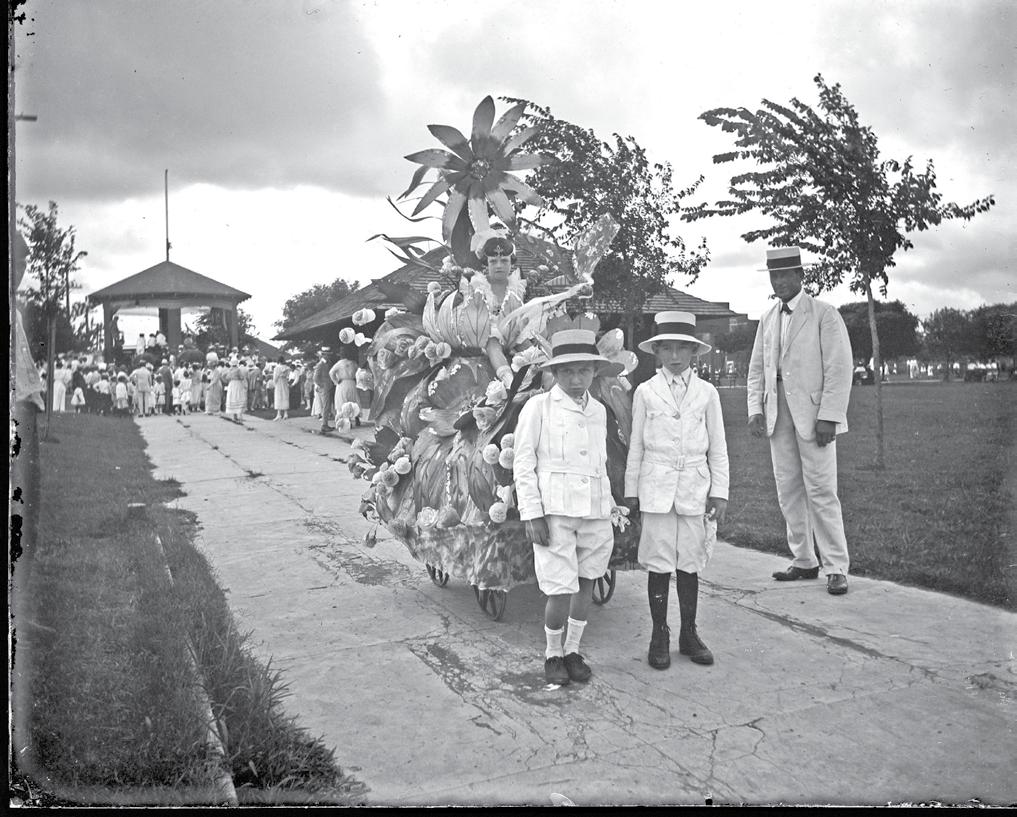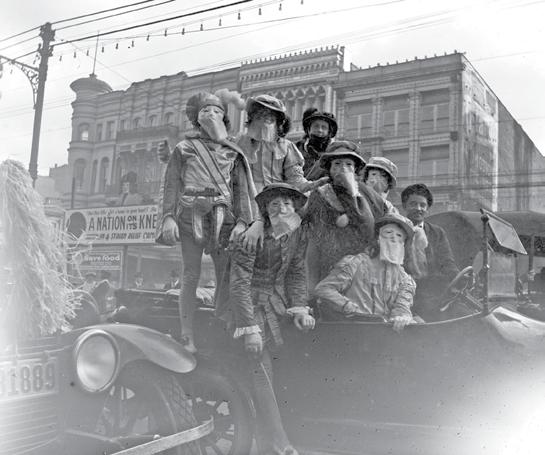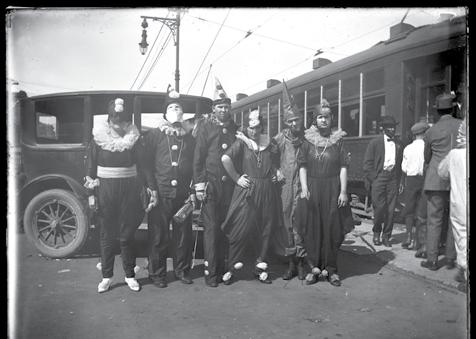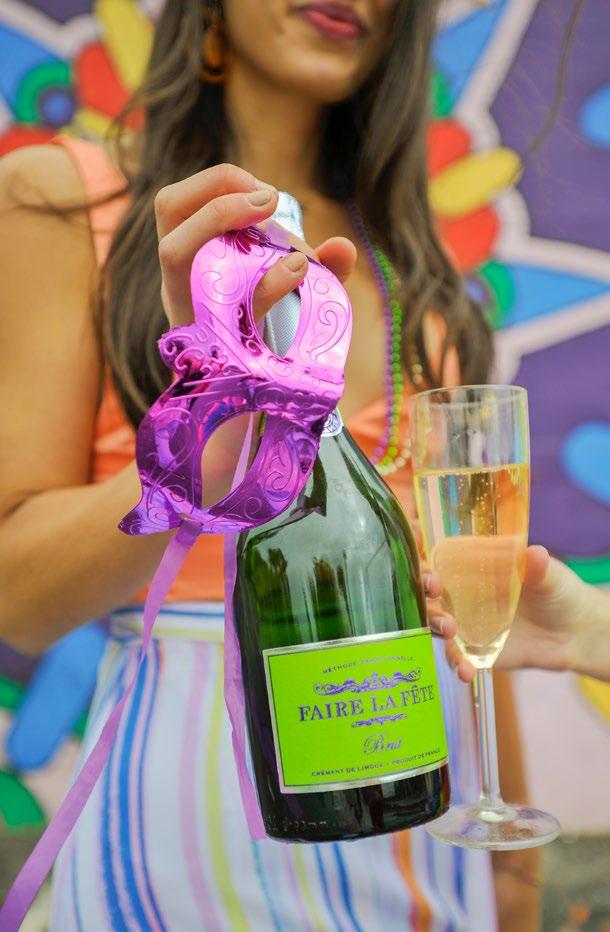
7 minute read
Cancelling Carnival: The Times Mardi Gras was Called Off

CARNIVAL:The Times CANCELLING Six Mardi Gras Maskers Revelers had spontaneous celebrations on Canal Street when festivities were cancelled in 19181919
That Mardi Gras Was Called Off most prevalent. Poor sanitation and a lack of understanding that stagnant water and mosquitos helped to spread the disease led New Orleans Impromptu Celebrations on Canal St. On Mardi Gras Day in 1919, Rex did not parade because of the recently ended war. Instead, Many people held their own, and roamed the streets in costume. Few things are By Burke Bischoff Algiers Float in St. Roch, 1919 to experience constant outbreaks. During an 1878 epidemic that was tearing through the Lower Mississippi Valley, New Orleans saw 20,000 infections, 5,000 deaths, and about 20 percent of the city’s population leave. as synonymous with New Since its inception in 1857, New Therefore, in 1879, only Rex rolled on Mardi Gras Day, while other krewes did not. Orleans’s identity as Mardi Gras. While Mobile may have been the Orleans Mardi Gras has either been cancelled or massively scaled back 13 other times. There have been instances of disease and local conflict putting a When New Orleans entered into the 20th century, three major wars hampered the city’s parade krewes. The first was when the United States got involved in World War I, which first city in America to celebrate stop to parading, but most of the cancellations were triggered by war, the first instance being the Civil War. stopped Carnival in 1918. Plus, Spanish flu was in full force that same year, so that didn’t help the situation. With 54,000 Carnival, popular culture New Orleans was, at the time, the largest city in the infected and 3,500 deaths, it was no surprise that Mardi Gras recognizes New Orleans as the South, and its location on the Mississippi River made it an important lifeline for the Confederate Army, as 1919 ended up not taking place. After that, World War II effectively knocked out parades from 1942 to 1945. And then, epicenter of American Mardi Gras, because traditions such as well as a major target for the Union. This eventually led to the city’s capture by Union forces and its new military governor, Benjamin Butler, imposing a harsh in 1951, President Harry Truman declared a state of emergency because of the Korean War, thus cancelling the Comus, Rex, Proteus, and Momus parades again for that year. However, parades with floats and throws martial law during his control of the city. So, from 1862 to when the war ended in 1865, the Mistick Krewe of many members of different krewes did end up getting together to throw a ball on Lundi Gras and to do one patriotic-themed originated here. So when Mayor Comus, the oldest and only New Orleans krewe at the parade on Mardi Gras Day as the Krewe of Patria. LaToya Cantrell announced time, did not parade. In 1875, during Reconstruction, both Comus and Before the recent COVID-19 cancellation, the last time parades didn’t roll in New Orleans was in 1979 because of a on November 17, 2020, that no parades are allowed to roll the newly formed Rex decided not to parade, due to civil unrest brought on by the Battle of Liberty Place. This event saw the Crescent City White League, pretty conflict between the New Orleans Police Department and Mayor Ernest “Dutch” Morial. The Police Association of New Orleans demanded a salary increase, which the mayor refused to give. for Carnival 2021 because of much a local terrorist militia made up of Confederate veterans, attempting to overthrow the Louisiana state In retaliation, NOPD decided to strike right before Mardi Gras Day, stopping Carnival dead in its tracks. As a result, many of COVID-19, no doubt many government. On September 14, 1874, 5,000 members the krewes either decided not to have a parade (including Rex, heard that as Mardi Gras being of the league stormed onto Canal Street, fought against local police and state militia, and occupied City Hall and Comus, and Zulu) or moved to neighboring parishes instead. While not having Mardi Gras parades this year does hurt in officially cancelled for this year. While it’s certainly disheartening parts of Downtown for three days. League members eventually left the city because federal troops were being brought in as reinforcements. This conflict left the moment, it has to be put into perspective. For a tradition that has been going on for about 163 years, to have only 14 cancellations—and those usually because of a major national or not to have familiar festive levity more than 30 people dead and almost 80 injured. Just four years later, New Orleans found itself in the world event—is pretty amazing. Even more remarkable is the sheer resilience of New Orleanians. More often than not, even after the slog that was 2020, this middle of a crisis that was all too familiar: yellow fever. when parades couldn’t happen, costume balls were still thrown, is not the only time in the city’s With it being a major port city, New Orleans was always in contact with many ships, cargo, and crew from people gathered in the streets for impromptu parades—Mardi Gras still happened. Carnival is in the city’s blood, so locals history that Carnival parades were banned. Africa, the Caribbean, and South America. This, in turn, left the city vulnerable to any foreign diseases that these ships carried, and yellow fever was one of the won’t stop celebrating it, even if there are no parades or krewes. But still, let’s hope some floats and good times can roll again in 2022.

A FAIRE OF THE HEART:

There’s New Orleans Love in Every Bottle of Faire la Fête Sparkling Wine

Faire la Fête is a unique sparkling wine that is like New Orleans in liquid form: It’s got history, flavor, and effervescence. Its label shows the Mardi Gras colors of purple and green; its name is the French translation of “to party”—one of the things that New Orleanians do best. And its story is one man’s quest to capture his love for New Orleans in a bottle and to share it with the world.
Champagne-drinkers say that, almost instantly, the bubbles get to them, leaving them feeling lightheadedly content or even surprisingly euphoric. It can’t be purely by coincidence, then, that wine expert Peter Baedeker experienced a very similar feeling the minute he set foot in New Orleans, when he arrived from California as a Tulane student years ago.
“I was one of those people who fell in love from the moment I walked down St. Charles for the first time,” Baedeker says. “New Orleans was in my blood.”
He fell in love yet again later, when he met his now-wife Erica, proposed to her at Jazz Fest, and married her in the Lower Garden District. The couple would have happily stayed in New Orleans permanently, sipping their wine from go-cups, but Hurricane Katrina chased them off.
Baedeker returned to California and began working in the wine business. During a trip with a wine distributor to southwestern France in 2010, he visited the small town of Limoux, near Carcassonne. Like most wine experts—even master sommeliers—and the majority of the wine-drinking world, Baedeker thought that the Champagne region of northeastern France had invented sparkling wine. He was surprised to discover, therefore, that the real creators of sparkling wine are the ancestors of the farmers of Limoux, who first began making it as far back as 1531—long before Champagne stole both the bubbly’s characteristic in-bottle fermentation process and the credit for its creation.
And that’s not all that Limoux is known for. They also have been celebrating Mardi Gras, which they call a “Fête,” every year since 1532, in honor of their fizzy masterpiece. It’s the longest-standing Carnival celebration in Europe.
“It was so reminiscent of New Orleans, I couldn’t believe it,” explains Baedeker. “They masked; it’s got the classic colors of green and purple and gold. They do it during the Carnival season, and they just keep doing these big parties. It’s centered around the fact that they invented sparkling wine and really never got credit for it.”
The Fête festivities culminate in the town center of Limoux, where the historic fountain there is emptied of water and filled instead with Limoux sparkling wine.
“I was like, ‘Oh my gosh, this is like a mini-New Orleans. This ties together everything I love, which is wine—especially champagne—and the New Orleans culture of Mardi Gras and the Fête,’” he says. “It was very much tied to this city that I, to this day, still love.”
He knew then that he had to somehow recognize the connection to New Orleans and to celebrate those things that he so adores. Baedeker was bubbling with enthusiasm about the bubbly. And ever since that moment, he has been keeping his feelings bottled up—in the form of Faire la Fête.

Effervescence 1036 N. Rampart St. nolabubbles.com
WHERE TO FIND FAIRE LA FÊTE: fairelafetewines.com
Spirit Wine
3500 Magazine St. spirit-wine.com
Acquistapace’s
125 E. 21st Ave. Covington acquistapace.com
Acquistapace’s 631 N. Causeway Blvd. Mandeville acquistapace.com
Compère Lapin 535 Tchoupitoulas St. comperelapin.com










